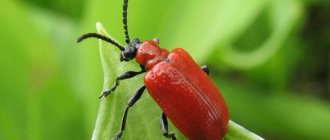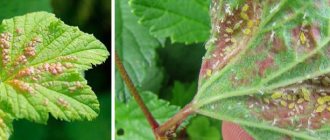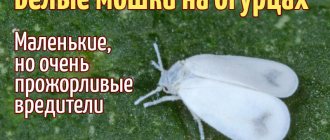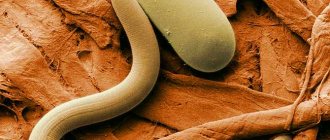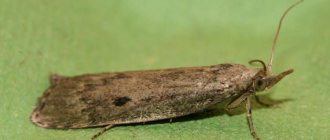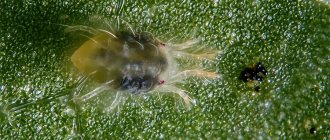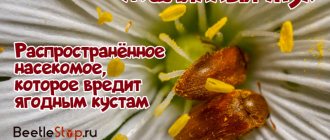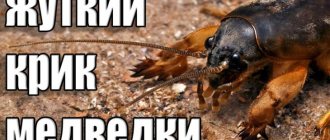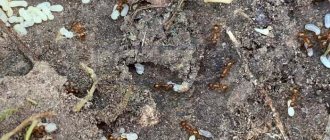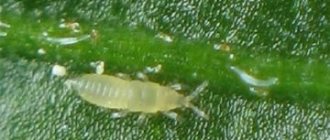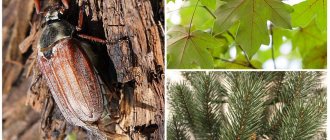From the article you will learn about pests of plants and fungi - fungus gnats.
Unpleasant insects with the strange name “fungus gnats” often appear when growing indoor flowers and vegetable seedlings. Their scientific name is sciaridae , Latin name Sciaridae . Mosquitoes belong to the order Diptera and number a thousand species.
Read another article on our website on the topic: “Nitroammophoska fertilizer” . You will learn about the use in the garden for cucumbers, tomatoes, peppers, strawberries, grapes, seedlings, indoor flowers, trees, and also find instructions for use and reviews.
Fungus gnats pose no danger to humans. Their target is the roots of flowers and their leaves. Sciarides attack the root system of plants, which leads to their wilting. How to deal with these insects? This is described in the article. Read on.
Fungus gnats in mushrooms, indoor flowers, seedlings: what is the danger?
Both adult sciarids and larvae damage mushrooms by sucking the juice out of them. The mushrooms themselves turn into a sponge. Fungus gnats in indoor flowers, on seedlings - what is the danger?
- On indoor flowers or other plants growing in greenhouses, on moist, loose soil, females lay eggs in close proximity to the roots.
- The hatched larvae begin to feed intensively, damaging the upper layers of the root bark.
- The absorption process is disrupted and the plant gradually withers.
The first signs of damage to a plant by fungus gnat larvae are discoloration and yellowing of the leaves. Voracious caterpillars, making passages in the bark, often introduce a fungal infection. Soil moisture promotes its rapid spread. If the seedlings are very small and there are few organic inclusions in the soil, the larvae happily eat green leaves, and sometimes the entire plant. Therefore, the seedlings quickly die.
Adult insects do not feed on plant juices. They jump from one plant to another, pick up fungal spores on themselves, and other infectious materials on their paws: rot, mold and cobwebs. Thus, adult sciarids very quickly spread plant diseases. Adult sciarids are especially dangerous for fungi, to which they transmit specific fungal diseases.
Description and appearance
Experts identify about 1.5 thousand species of this insect. But gardeners at home most often encounter only one of them, namely sciaridae.
Fungus gnat
The size of an adult insect is 3-4 mm. The fungus gnat has a narrow, elongated body and a rounded head. The color of the insect is gray or black. In the thoracic region there are three pairs of thin paws. In the frontal part there are elongated whiskers that help the insect navigate in space. The fungus gnat has one pair of transparent wings. Adults do not feed; their main function is to breed offspring.
Sciarid larvae
The larvae of the fungus gnat are worm-shaped and legless. Their body length at birth does not exceed 2 mm, and during development it reaches 10 mm. The larvae have a dark head and a transparent light body color, through which the intestines are visible. The mouthparts are gnawing type. Large larvae are capable of leaving a slimy trail on the soil surface as they move.
Differences between fungus gnats and fruit gnats
Differences between fungus gnats and fruit gnats
In fact, sciarids are very similar to fruit gnats. Although, unlike fungus gnats, the Drosophila fruit fly does not harm plants. She also lays eggs in moist soil in flower pots. Unlike sciarids, after hatching, fruit midge larvae do not damage the plant and do not go deeper into the soil.
The fruit fly has distinct differences from sciarids:
- Drosophila is smaller in size, has a small dark elongated body with a large head on which huge eyes are located.
- They are sometimes colored red. This can be seen in the picture above.
- Drosophila has no antennae.
- Let us remember that sciarids have a more elongated body with a small black head, small eyes and black mustache, consisting of separate segments. The legs are thinner and longer.
In the middle zone, the most dangerous sciarids are the species Bradisia , Sciara and Licorella. The most active breeding season for insects occurs in late autumn. During this period, the soil is still watered, and evaporation occurs much more slowly.
The accelerated reproduction of fungus gnats is facilitated by:
- Abundant hydration
- Lack of drainage layer and holes in pots and flower containers
- Using dried tea leaves as mulch
- The presence of moss or lime deposits on the pots
- There is water in the pan for too long
To determine the most effective ways to combat harmful insects, you need to develop an unbreakable rule for yourself: any new plant that enters the house must undergo a two-week quarantine. The plant is carefully examined and preferably transplanted into a new pot. Only after this can the pot with the plant be brought into the room where the house flowers are located. Be sure to block all possible ways for pests to enter a room or greenhouse: take care of the safety of ventilation ducts and the absence of stale fruits or flowers brought, for example, from the forest.
Control measures are described below. Read on.
Preventive measures
Preventive measures must be followed to prevent pests such as sciarids from infesting your indoor flowers. The following will prevent the appearance of the insects we are studying.
- The soil that you have prepared for planting or replanting a houseplant should be clean, free from residues and rot.
- Before pouring the soil into the pot, treat it with potassium permanganate and sprinkle with charcoal.
- You need to wash the pot with hot water before using it, and also disinfect it with the same potassium permanganate.
- Coarse sand, ceramic fragments, expanded clay, and gravel will provide drainage. Sprinkle it over the top layer of soil.
- Don't go overboard with organic fertilizers: add moderate amounts of compost and manure to the soil.
- Coffee grounds, tea leaves, and dairy products such as kefir and milk do not make good fertilizers.
- Houseplants should be watered exclusively with clean water.
- If there is excess water left in the flower tray after watering, it should be poured out.
- Plants should not be watered frequently. Only after the top layer of soil has dried can the watering procedure be repeated.
- Rotting remains of indoor flowers need to be disposed of in a timely manner.
If you comply with the above conditions, flower gnats will not appear in your plants at home.
How to get rid of fungus gnats, how to get rid of them - effective means of control: insecticides, drugs
Aktara is an effective means of combating fungus gnats.
If you find adult insects in a pot with a new flower, it is worth taking a closer look at what kind of midges have settled in your farm. If pests are still found in the pot, they can be destroyed with one of the repellents such as Dichlorvos, Raid or Raptor . And then you need to do the following:
- Check the soil for the presence of larvae.
- They are clearly visible if you lightly pick at the ground. It will become loose.
- The larvae are visible as shiny inclusions under the light. Just remove them from the ground.
What else can you do to get rid of fungus gnats? To destroy them, various other effective means of control are also used. Here are popular insecticides, drugs, methods:
- Chemical preparations - insecticides such as "Aktar" or "Aktellika" . The dilution method is indicated on the packaging.
- The mechanical method is to remove the larvae manually. It will take patience and a couple or three days. The larvae are dark and small, blending into the ground. But in two or three steps, the larvae can either be selected or crushed.
It should be remembered: Treatment with toxic drugs “Dichlorvos”, “Raptor”, “Aktara” must be carried out in personal protective equipment: masks, gloves and goggles. Don't eat food with dirty hands!
Experienced gardeners often mulch seedlings with natural diatomite flour. It has insecticidal and adsorption properties, and is part of insecticides. As a means of combating fungus gnat larvae, soil insecticides in the form of granules are used: “Grom-2 ” or “Bazudin” . It is introduced in two ways:
- Scatter several granules over the surface of the soil in a flower pot, and then mix with the soil so that the granules are covered. Water the flower; streams of water will erode the granules and destroy insect larvae.
- The second method of application is to remove a layer of soil to a depth of 2-3 centimeters and mix it with granules.
In addition to these methods of controlling detected pests, there are several more gentle ones. Read on.
Reasons for appearance
As a rule, flies come to the grower with soil contaminated with their larvae, from which, under favorable conditions, adult flying insects hatch.
It is important to check the quality and carry out preventative treatment of the soil in which you plant the plant, but the presence of flying flies may not be related to your actions.
Often flies are a signal of an unfavorable environmental situation in the house . They did not necessarily come from the pot of a plant standing on the window. Like most insects, midges fly to the light, that is, to the window, next to which they enjoy sitting and flying, but they could have flown in from the outside.
These insects love a warm and humid atmosphere, so they live with great pleasure in damp basements of residential buildings and can visit through hoods, pipes and ventilation shafts, especially in the toilet. Having flown into a gardener’s apartment, they may well take root, laying eggs on the surface of the soil of a recently watered plant and infecting it with their larvae.
Sciarids can also covet food waste (spoiled fruits, vegetables) in the trash can, and linger in the winter vegetable reserves (potatoes, onions). If you are “lucky”, they can find a home in a completely unexpected place, if your apple has rolled somewhere and remained unnoticed, for example, an apple (or its core, which is even worse). Here, treating your flowers with chemicals will not help; you must find and, if possible, eliminate the source.
to contents
How can you fight fungus gnats without harmful chemicals?
Neem oil helps fight fungus gnats without harmful chemicals.
To destroy the harmful insect, you can also use environmentally friendly means of control. How can you fight fungus gnats without harmful chemicals? Several methods are described below.
NEEM OIL:
- A recognized drug among experienced gardeners and gardeners.
- It is an Ayurvedic remedy with a strong characteristic odor of garlic and rotten leaves, obtained from the fruit of the neem tree. It grows in India and has antiseptic and antifungal properties.
- It is used to kill ticks and various insect pests.
- Completely safe for people.
- The unpleasant odor of the oil repels adults from the ground. Oviposition does not occur.
Affected plants are treated:
- Spray the stems and leaves with a solution of oil in water , prepared in a ratio of 5 ml of oil per 1 liter of water . The mixture is shaken for a very long time until a suspension is obtained, since the oil is very thick. To completely destroy pests, two or three treatments are carried out at intervals of one and a half or two weeks.
- Watering the soil under the plant to destroy the larvae.
"FITOVERM":
- It is popular among experienced gardeners and simply lovers of home flowers.
- It is used to destroy most insect pests on vegetable, fruit, berry crops and indoor plants in open and protected soils.
- The effectiveness and safety of the drug has been confirmed by gardeners, gardeners and simply lovers of home flowers many times.
There are many different natural remedies for controlling plant pests on the iHerb website . These are natural preparations that will not harm either people or plants.
SPRAYING WITH ALCOHOL SOLUTION:
- 250 milliliters of alcohol are brought to 1 liter , the finished solution is sprayed on the plants and the ground around them.
- First, you can try the concentration for the plant on one leaf to prevent burns to the seedlings or spoil the entire flower.
IRRIGATION WITH HYDROGEN PEROXIDE SOLUTION:
It is prepared as follows:
- Add 30 milliliters of 3% hydrogen peroxide .
- When peroxide gets on the larva, it kills it.
- Several treatments may be needed.
DRYING THE SOIL:
- To destroy larvae in the soil, experienced gardeners offer another very simple method: dry the soil surface to a depth of at least 2 centimeters in small-diameter pots, and at least 4-5 centimeters in large-volume pots.
- Due to the fact that the larvae love moisture, they will not be able to move and feed in dry soil. Therefore, sciarids will not reproduce.
The most radical method of destroying adult sciarids and their larvae is replanting them in new soil. The flower is freed from contaminated soil, the roots can be thoroughly examined and washed. Then plant the plant in a clean, uninfected substrate.
Fighting fly eggs
To combat the eggs laid by the fungus gnat, the soil can be shed several times with a weak solution of potassium permanganate.
An effective remedy is the Citropak tablet. Its fourth part is diluted in 5 liters of water. The resulting solution is watered onto the soil. Just one treatment will bring tangible results. But the process can be repeated several more times to consolidate success.
Drying the soil in a pot can also bring positive results. But in this case, it is very important that the plant itself does not die. Its need for water must be taken into account.
Prevention measures against fungus gnats
Preventative measures against fungus gnats
To prevent harmful insects from appearing in your greenhouse or on indoor flowers, preventive measures must be taken. First of all, it is necessary to check the possibility of sciarids getting into the house or greenhouse. This can happen through contaminated soil, through ventilation ducts and warm basements located under apartments where flowers or containers with seedlings are located.
- The easiest way is to replace the soil when transplanting flowers from one pot to another.
- Before planting, it must for at least 30 minutes , or kept in the freezer for a day. These are the most reliable methods.
- It’s not bad if the soil contains remains of pine needles or bark, or coarse-fibered peat. You just need to make sure that such additives do not harm the planted plant.
You can also use:
- Moderate watering of plants . It is enough that the top layer of 1.5-2 centimeters is dry. The soil will immediately become unattractive to mosquitoes.
- Watering from a tray . Each flower pot has drainage holes. To keep the top layers of soil dry, place the flower pot in a tray with water. Then the water will rise to the roots of the plant through the drainage holes. Sciarides will not be able to lay eggs in the ground.
- Timely removal of dry leaves or wilted parts of the plant that attract insects.
- A layer of sand should be poured on top of the soil , approximately 1-1.5 centimeters . Then excess water will flow down to the root. The top sand layer always remains dry and unattractive to fungus gnats.
- Do not use dairy drinks, “meat water”, drunken tea or coffee, or crushed leaves to feed plants , as they quickly rot and become an ideal place for the development of sciarid larvae.
- Timely and frequent ventilation of the room to keep air humidity at a constant level.
- Using sticky traps . More often they buy ready-made adhesive tapes.
You can prepare the last described trap yourself:
- Place a sheet of yellow paper on a wooden stick or a regular table fork in a container with a flower or seedling.
- Lubricate it with regular cosmetic Vaseline.
- After filling the trap, change the sheet.
As a preventive measure, mulching with diatomite flour . It consists of abrasive and strong absorbent materials. Once on the larvae, flour particles dehydrate them and then immobilize them. To effectively control fungus gnats, flour is scattered over the surface of dry soil. Otherwise, the moisture will be absorbed into the flour particles, and it will not be able to act on the larvae.
Important: Carry out all preventive work before planting seeds for seedlings. It is necessary to treat both the seeds against diseases and the soil for the presence of harmful spores and larvae.
With the advent of their own experience, flower growers choose their most favorite methods of combating and preventing harmful insects. Indeed, in each specific case, one or a couple of the methods proposed above for destroying sciarids will work. Good luck!
Reproduction and development stages
Female sciarids lay eggs on the surface of moist soil or directly into the soil near the roots of the plant. After 5-7 days, larvae emerge from them. They begin to actively feed, which determines their accelerated pace of development. The sciarid remains in the larval stage for 2 weeks. At the last stage of development, they become inactive, and their appetite decreases. After this, the sciarid larvae pupate.
After 3-4 days, adults emerge from them. And after a day, new adult sciarids are ready to independently breed offspring, and the cycle resumes. The lifespan of females is 3-4 weeks. During this period, the sciarid lays from 50 to 300 eggs. Optimal conditions for reproduction: temperature +240C and humidity level 75-100%.
When to see a doctor
A person should seek medical help if a burning sensation when urinating lasts longer than a few days, or if there is:
- blood in urine
- fever
- lower back pain
These may be signs of serious illnesses such as a kidney infection.
Older adults, children, and pregnant women should see a doctor if they have symptoms of a UTI.
A UTI can affect any part of the urinary tract, which includes:
- ureters
- bladder
- urethra
- kidneys
Women are more likely to develop UTIs than men because the female urethra is shorter. A short urethra makes it easier for bacteria to access the bladder, ureters or kidneys. Research shows that about women have UTIs. The urethra is also closer to the anus, which contains bacteria that cause UTIs.
Diagnostics
The doctor will ask about the person's symptoms and medical history and may check for signs of fever or UTI to rule out this diagnosis. The most common diagnostic test for UTIs is a urine test. The presence of bacteria and white blood cells can indicate whether the body is fighting an infection. Imaging tests can also give a picture of the health of the urinary tract and identify problems such as blockage or damage. The doctor may also use a cystoscope, which is a camera on a long, thin tube. This device allows you to examine your urethra and bladder for signs of infection.
Symptoms of the presence of midges in orchids
Insects are not difficult to see; above a pot with an orchid, a swarm of black midges is clearly visible, and on the leaves and fragments of the substrate they are noticeable with the naked eye.
However, you can only determine whether they are harmful by removing the plant from the pot. We invite you to familiarize yourself with Growing peanuts in the country and at home
The orchid, one way or another, will have to be replanted, because the very fact of the appearance of a large number of midges already tells the gardener that not all is well with the substrate. Therefore, it is necessary to make sure that everything is in order with the orchid’s root system and replant it in a fresh soil mixture that excludes mold fungi and green algae deposits.
During transplantation, the roots are carefully inspected, washed in a weak solution of potassium permanganate, and the wounds, if any, are sprinkled with activated carbon powder or cinnamon to prevent bacterial or fungal infections from entering them. The transplanted plants are kept more dry than usual for 4–7 days.
What types of dizziness are there?
There are two types of vertigo: central and peripheral. Central vertigo occurs due to problems related to the brain. Research shows that dizziness is central in about 20% of cases.
Peripheral vertigo, the second type, which is associated with problems of the inner ear or vestibular system. Peripheral vertigo accounts for approximately 80% of vertigo cases. Peripheral vertigo is caused by a health problem called benign paroxysmal positional vertigo. This may be the result of calcium carbonate crystals shifting in the inner ear, which disrupts a person's balance.
Exercise may be especially beneficial for patients with peripheral vertigo, as the activity will help redistribute the crystals. For patients with central vertigo, exercise may be less effective.
Several different exercises can help reduce dizziness. Typically, these exercises are considered either as vestibular rehabilitation therapy or as part of a canal repositioning procedure.
Some examples include:
Cleaning the room after treatment
What does a mushroom consist of?
It is better to clean the room where the mycelium is located the next day. The first step is thorough ventilation. Hands must be protected with rubber gloves. It’s better to go out while airing out.
The next step is washing all surfaces. You can add a cleaning agent to the water, this will speed up the process and will perfectly wash off any remaining chemicals. The addition of chlorine is also recommended. You need to wash not only the floors, but also the walls and windows.
Pay special attention to the part of the room in which the mycelium is located.
After thorough cleaning, begin inspecting the soil and mushrooms. It is better to remove the top layer of compost and replace it with fresh one. This will remove the pest larvae. In flowers it is easier to do this by changing the entire soil; in the case of mushrooms, you will have to be content with a partial replacement.
Characteristics of an insect
Sciarids are small insects that belong to the order Diptera. They arose several centuries ago and were studied by scientists for a long time.
More than 2 thousand varieties are described in scientific books. Some have not been studied by specialists, so detailed information is not available.
Adults are small flies, their body length is 4 mm. They have a dark gray or black tint.
Watering plants and flowers becomes less intense, and the soil dries out slowly. The acidity level in the soil increases, so insects begin to actively reproduce.
Note! It is not midges that cause damage to plants, but larvae. They feed on roots and suppress the plant's strength.
Gradually it withers and rots
They feed on roots and suppress the plant's strength. Gradually it withers and rots.
